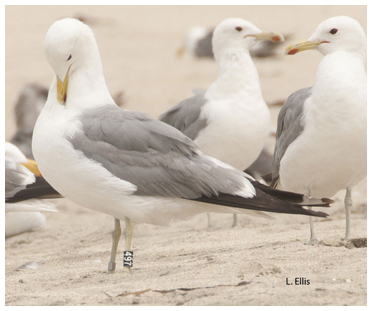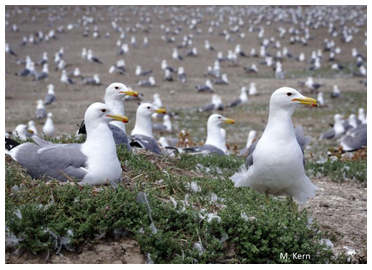Mono Lake Wildlife
Mono has been called a "dead sea" but it actually abounds with life. Few animals can tolerate Mono's salty, alkaline water, but these few species thrive in astronomical numbers.The food chain begins with green algae, a microscopic one-celled plant. Algae uses decayed organic matter and sunlight to grow. In the winter, when the algae blooms, the lake may become pea soup green.
Two animals feast on the algae: the brine shrimp and the brine fly.
Brine fly females can actually walk into the lake in an air bubble and lay their eggs on pieces of rock or tufa. The egg becomes a larva and then a pupa before the adult fly finally emerges. The pupa stage of the brine fly was collected by the local Kuzedika Paiute Indians, and used as a food source and trade item. "Mono" is the Yokuts Indian word for "brine fly".
The half-inch long brine shrimp can be seen in Mono Lake from April through October. At the height of the summer season an estimated four trillion shrimp swim in Mono's waters. As winter approaches, the adult brine shrimp begin to die off, but not before eggs are laid that will overwinter in the lake bottom mud. The eggs hatch out as the lake water warms in the spring. Mono's shrimp (Artemia monica) are thought to be a unique species that has adapted to Mono's special conditions.
Mono's shrimp and flies provide a plentiful food supply for more than eighty species of migratory birds that visit the lake each spring and summer. Particularly notable bird species include three migrants: eared grebes, Wilson's and red-necked phalaropes, and two nesting species, California gulls and snowy plovers.
The small, graceful pahalaropes are delighted to watch as they pick brine flies off the surface of the lake or snatch them from the air. About 150,000 phalaropes visit Mono Lake in July and August. They winter in warmer South American climates.
Eared grebes visit Mono Lake in astonishing numbers. An estimated 800,000 of them make a spectacular sight during the fall migration from August through October. Grebes can be seen diving for food in the lake, but are never seen on land as their legs are designed for swimming rather than walking.
About 50,000 adult California gulls fly to Mono Lake from the coast each spring to nest where food and island nesting sites are plentiful. Approximately 90% of the California population of this species is born at Mono Lake.
Snowy plovers nest along the windswept alkali flats of Mono Lake's eastern shore. The colony of 400 birds is about 10% of the California population of this species.
Source: State of California, U.S. Forest Service

California gull - USGS - L. Ellis

Gulls nesting USGS - M. Kern

Eared grebe breeding colors - D. Barnum, USGS